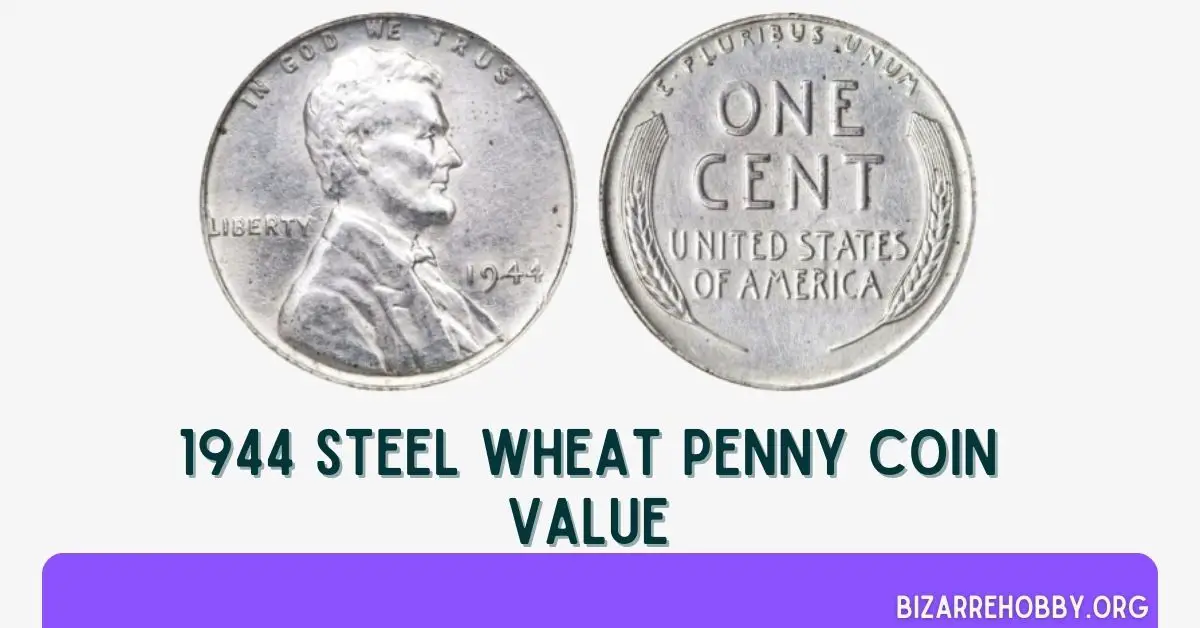In the midst of World War II, the United States Mint produced an astounding quantity of 1944 steel wheat pennies—over two billion to be precise. These coins, featuring Abraham Lincoln on the obverse and two wheat stalks on the reverse, have become a familiar sight to many Americans. Despite their age, approaching nearly eight decades, their abundance has kept their value relatively modest in today’s numismatic market.
However, a fascinating anomaly emerged from this sea of copper coins. In a rare twist of fate, a small number of 1944 pennies were mistakenly struck using steel planchets—the metal discs from which coins are made.
This error was particularly intriguing because the Mint had used steel for pennies in 1943 to conserve copper for the war effort, but had intended to revert to copper in 1944.
Numismatists theorize that these steel planchets may have been leftover from the previous year’s production, accidentally mixed in with the copper blanks and overlooked during the minting process.
Whatever the cause, these steel pennies found their way into circulation, creating a numismatic treasure hunt that continues to this day.
The scarcity of these steel variants, combined with their historical significance and the intrigue surrounding their creation, has made them highly prized among coin collectors.
As a result, the market value of a 1944 steel penny far exceeds that of its copper counterparts, with prices varying based on factors such as mint marks (“D” for Denver, “S” for San Francisco, or no mark for Philadelphia) and the coin’s condition.
Table of Contents
- Value Chart for 1944 Steel Wheat Penny
- History of the 1944 Steel Wheat Penny
- Types of 1944 Steel Wheat Penny
- Features of the 1944 Steel Wheat Penny
- 1944 Steel Wheat Penny Grading
- 1944 Steel Wheat Penny Value Guides
- Rare 1944 Steel Wheat Penny Error List
- Where to Sell Your 1944 Lincoln Steel Penny?
- FAQs on 1944 Steel Wheat Penny
- Final Thoughts
Value Chart for 1944 Steel Wheat Penny
| Condition | 1944 No mint mark steel penny | 1944 D steel penny | 1944 S Steel Penny |
|---|---|---|---|
| Extra fine | $28,893 | $34,803 | $409,304 |
| AU | $34,803 | $46,688 | $759,524 |
| MS 60 | $58,491 | $62,001 | $1,137,794 |
History of the 1944 Steel Wheat Penny
While steel pennies were commonplace in 1943 due to wartime copper conservation efforts, their appearance in 1944 is an anomaly that has puzzled numismatists for decades. The United States Mint had intended to resume bronze penny production in 1944, making the handful of steel cents from that year—estimated at only a few dozen—exceptionally rare and mysterious.
The exact circumstances leading to the creation of these 1944 steel wheat pennies remain a subject of debate among coin experts. One prevailing theory suggests that leftover steel planchets from the previous year’s production may have been inadvertently left in the coining presses.
Another intriguing possibility stems from the fact that the Philadelphia Mint was simultaneously producing steel two-franc coins for Belgium in 1944. This concurrent production might have led to an accidental mix-up of planchets.
However, these theories fail to explain the existence of 1944 steel wheat pennies from the Denver and San Francisco mints. The presence of these coins at multiple mint locations deepens the mystery, with some speculating that steel planchets were somehow distributed to these facilities by mistake.
Adding another layer of intrigue to the 1944 penny saga is the debate surrounding the composition of the bronze cents produced that year. Some numismatic historians claim that these pennies were made from recycled shell casings, tying the coins directly to the war effort.
However, this assertion is contested by others who view it as an embellished narrative aimed at fostering patriotic sentiment among the American public.
What is certain is that the production of steel pennies in 1943 was a direct response to the critical shortage of copper, which was needed for essential wartime materials such as shell casings and communication wires.
These 1943 coins, often referred to as “Steel Cents” or sometimes erroneously as “Silver Pennies,” contain no precious metals. Their silvery appearance is due to their zinc-coated steel composition, a stark departure from the traditional copper alloy.
The 1944 steel cents stand as a numismatic anomaly, bridging the gap between wartime necessity and peacetime normalcy in American coinage. Their rarity and the mystery surrounding their creation continue to captivate coin collectors and historians alike, making them highly sought-after pieces of monetary history.
Types of 1944 Steel Wheat Penny
| Location | Year | Minted |
|---|---|---|
| Philadelphia | 1944 No Mint mark bronze penny | 1,435,400,000 |
| Philadelphia | 1944 No Mint mark steel penny | About 30 |
| San Francisco | 1944 S bronze penny | 282,760,000 |
| San Francisco | 1944 S steel penny | 2 |
| Denver | 1944 D bronze penny | 430,578,000 |
| Denver | 1939 D steel penny | 7 |
| Total | NA | 2,148,738,000 + 39 |
Features of the 1944 Steel Wheat Penny
The 1944 steel wheat penny stands out from their copper counterparts due to it’s unique composition and appearance. These coins are crafted from a steel core with a thin zinc coating, resulting in a distinctive silvery hue.
However, due to the reactive nature of steel and zinc, many specimens have developed a powdery, slightly rusty surface over time. Despite this material difference, the overall design adheres to the standard Wheat penny format, based on Victor David Brenner’s iconic creation.
Obverse Design Of The 1944 Steel Wheat Penny
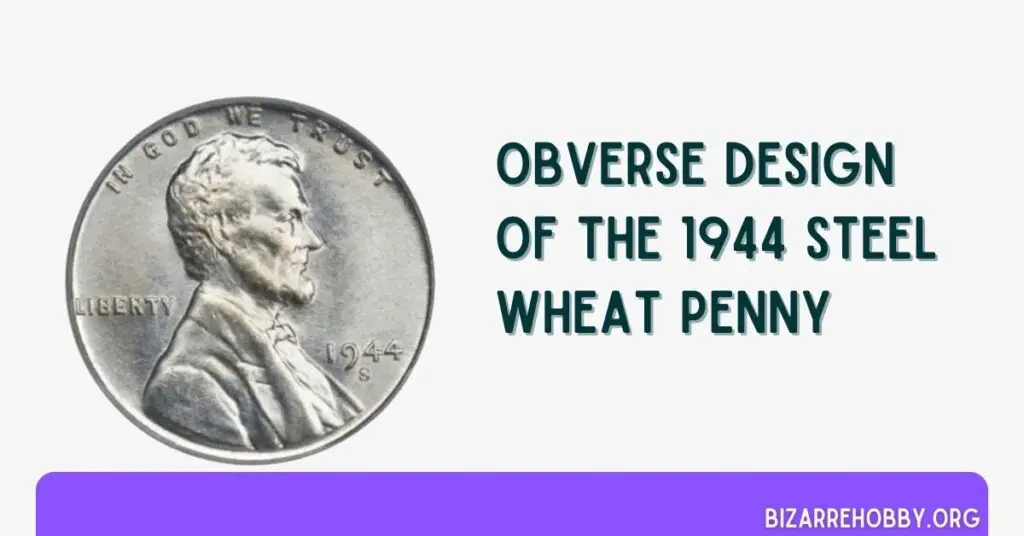
The obverse of the 1944 steel wheat penny maintains the familiar Lincoln profile that has graced American one-cent pieces since 1909. The 16th President’s bust faces right, with the motto “IN GOD WE TRUST” arching above. To the left of Lincoln’s portrait, you’ll find the word “LIBERTY,” while the date “1944” is positioned to the right.
Mint marks, when present, appear below the date. A “D” indicates production at the Denver Mint, while an “S” denotes the San Francisco Mint. Coins without a mint mark were struck at the Philadelphia Mint.
For those with keen eyes, the initials “VDB” (for designer Victor David Brenner) can be discerned at the cut-off of Lincoln’s shoulder, a subtle tribute to the coin’s creator.
Reverse Design of 1944 Steel Wheat Penny
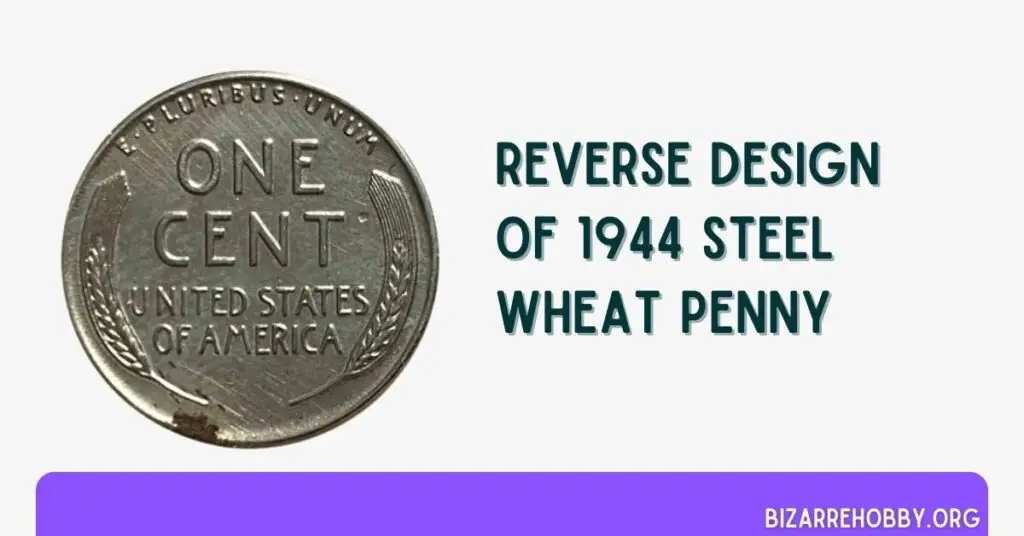
The reverse side of the 1944 steel penny mirrors that of other Wheat cents, showcasing a design that would continue until 1958. Two stylized wheat stalks frame the central elements, giving rise to the “Wheat penny” moniker.
The denomination “ONE CENT” is prominently displayed in the center, while “UNITED STATES OF AMERICA” is split into two lines above it in a smaller font. Crowning the design at the top of the coin is the Latin phrase “E·PLURIBUS·UNUM” (“Out of many, one”), a core motto of the United States.
This design, combining patriotic symbolism with agricultural motifs, reflects the values and identity of early 20th century America. The use of steel for these rare 1944 pennies adds an extra layer of historical significance, tangibly linking the coin to the resource management challenges of World War II.
The juxtaposition of this wartime material with the timeless wheat penny design makes the 1944 steel penny a unique artifact, capturing a moment when the demands of global conflict intersected with the everyday currency of American life.
Technical Specifications of 1944 Steel Wheat Penny
| Specification | Detail |
|---|---|
| Face Value | One cent ($0.01) |
| Shape | Round |
| Compound | Steel coated with zinc |
| Coin Thickness | 0.059055 inches (1.5 mm) |
| Coin Diameter | 0.75 inches (19.05 mm) |
| Coin Weight | 0.095310 ounces (2.702 g) |
| Edge | Plain |
1944 Steel Wheat Penny Grading
The 1944 steel Wheat penny presents a fascinating anomaly in the world of numismatic grading. Unlike most coins, where condition directly correlates with value, these rare steel pennies defy conventional grading norms.
Their scarcity and historical significance often overshadow typical preservation concerns, making them highly sought after in any condition.
While most coins see a steep price decline as their grade decreases, 1944 steel pennies maintain extraordinary value across the grading spectrum. Even specimens in lower grades can command prices in the hundreds of thousands of dollars, a testament to their rarity and the intense interest they generate among collectors.
Given the high value of these coins, it’s crucial to authenticate them. Here are key methods to determine if a 1944 penny is indeed made of steel:
- Visual Inspection: Genuine steel pennies have a distinct silvery appearance, often accompanied by surface rust due to the reactive nature of their metal composition. This contrasts sharply with the reddish-brown hue of standard bronze pennies.
- Weight Analysis: Steel pennies are notably lighter than their bronze counterparts. A genuine 1944 steel cent should weigh approximately 0.095310 ounces (2.702 grams). This is significantly less than the standard bronze penny, which weighs about 0.10970 ounces (3.11 grams).
- Magnetic Test: Perhaps the most definitive test is the use of a magnet. Steel is ferromagnetic, meaning a magnet will attract these pennies. This is a unique property among U.S. cents, as standard copper or bronze pennies do not respond to magnets.
It’s important to note that while these methods are helpful, professional authentication is recommended for any coin believed to be a 1944 steel cent, given their extreme rarity and value. Counterfeit coins do exist, and some may be quite convincing to the untrained eye.
| Grade Number | Grade |
|---|---|
| 1 | Basal State-1 |
| 2 | Fair |
| 3 | Very Fair |
| 4, 5, 6 | Good |
| 7, 8, 10 | Very Good |
| 12, 15 | Fine |
| 20, 30 | Very Fine |
| 40 | Extremely Fine |
| 50 | About Uncirculated |
| 60 | Mint State |
| 65 | Mint State |
| 70 | Mint State |
Please check my detailed guide on grading a Wheat Lincoln Penny.
1944 Steel Wheat Penny Value Guides
The 1944 steel Wheat penny, designed by Victor David Brenner, maintains the same visual appearance as other Wheat pennies of its era. The key distinction lies in its composition, making it a rare variation rather than a standard issue coin for that year.
It’s crucial to understand that the U.S. Mint primarily produced cupronickel pennies in 1944, returning to the standard composition after the 1943 steel cent year. The steel pennies from 1944 are, therefore, exceptionally rare errors or variations.
1944 Philadelphia Mint (No Mint Mark) Steel Penny Values
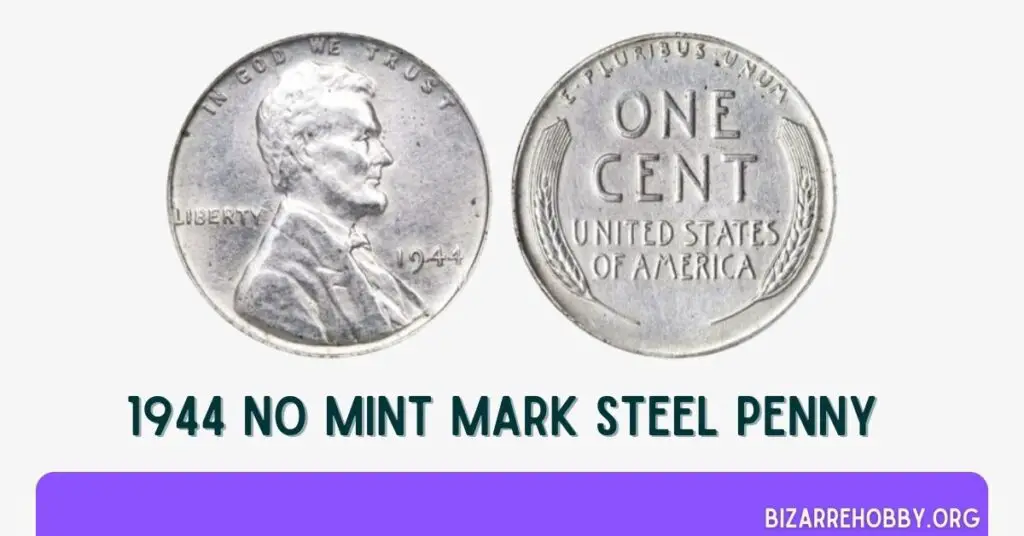
The Philadelphia Mint struck an estimated 1,435,400,000 cupronickel pennies in 1944. However, numismatists believe only about 25 to 40 steel pennies were accidentally produced here, with the exact number remaining a mystery.
The scarcity of these coins is reflected in their substantial market values:
- About Uncirculated condition: $26,500 to $40,800
- Mint State (MS) 60: $37,500 to $45,000
- MS 61: $40,000 to $48,000
- MS 62: $55,000 to $66,000
- MS 63: $75,000 to $90,000
Particularly rare are specimens graded MS 64, which typically command $120,000 to $140,000. However, the market has shown even higher potential, as evidenced by a 2021 auction where an MS 64 example sold for an astonishing $180,000.
These values underscore the immense collectible appeal of the 1944 steel cent. Their worth stems not just from their rarity, but from their status as unintended variations that offer a window into the complexities of coin production during a pivotal time in American history.
It’s worth noting that these values are indicative and can fluctuate based on market conditions, the specific characteristics of individual coins, and the dynamics of particular auctions or sales.
1944 D Steel Penny Value
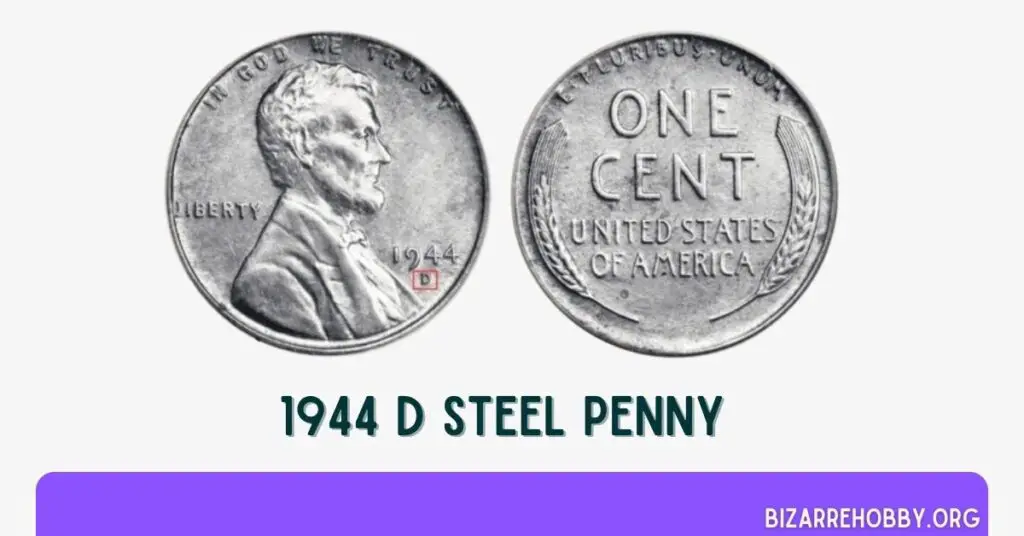
While the Denver Mint produced 430,578,000 regular copper pennies in 1944, it also accidentally struck seven steel cents. This minuscule number makes the 1944-D steel penny one of the rarest coins in American numismatics.
Estimated values for these coins are:
- About Uncirculated (AU): $30,000 to $36,000
- Mint State (MS) 60: $35,000 to $42,000
- MS 61: $40,000 to $48,000
- MS 62: $52,500 to $63,000
- MS 63: $80,000 to $96,000
Most known specimens are in mint state condition, highlighting their immediate recognition as unusual pieces. The highest recorded sale for a 1944-D steel cent occurred in 2007, when an MS 63 example achieved an impressive $115,000 at auction.
1944 S Steel Penny Value
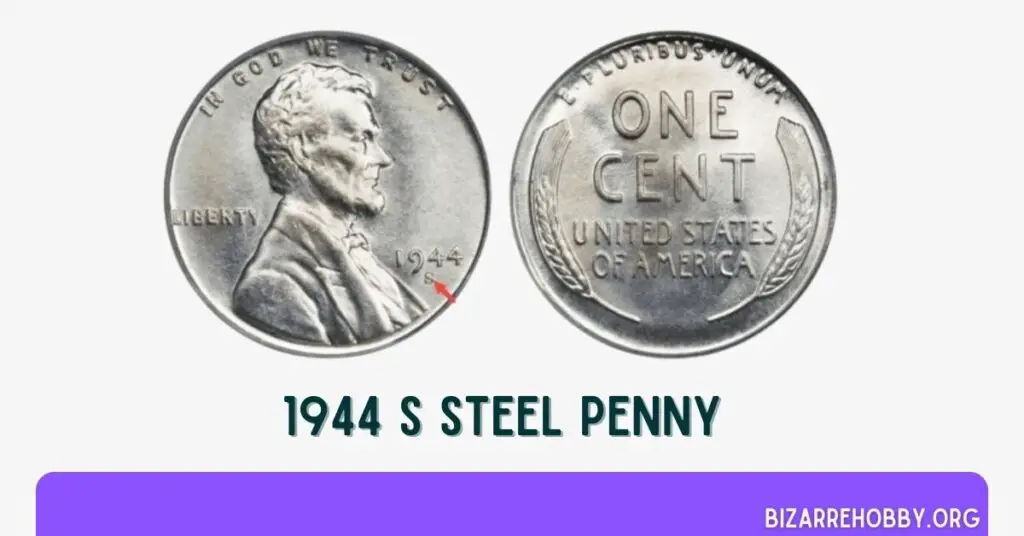
The San Francisco Mint’s production of two steel pennies in 1944, alongside its 282,760,000 standard cupronickel cents, remains an enigma. The extreme rarity of these coins has led to widely varying value estimates among numismatic authorities.
The US Coin Book provides these estimations:
- Extra Fine: $409,304
- About Uncirculated: $759,524
- MS 60: $1,137,794
However, other grading services offer more conservative estimates. PCGS suggests a value of $475,000 for a mint state coin, while NGC estimates $55,000 for an MS 64 grade, rising to $500,000 for an MS 66.
The most reliable indicator of value comes from actual auction results. In 2021, one of the two known 1944-S steel pennies, graded MS 66, sold for $408,000. This sale provides a concrete reference point for the coin’s current market value.
Standard 1944 Lincoln Bronze Penny Value
In stark contrast to their rare steel counterparts, the standard bronze pennies minted in 1944 are much more affordable for collectors. These coins, which represent the vast majority of 1944 penny production, typically range in value from $0.06 to $6, depending on their condition and mint of origin.
This relatively modest value reflects their high mintage numbers and subsequent abundance in the collector market. Despite being over 75 years old, these coins were produced in such large quantities that they remain relatively common today.
Here are some notable exceptions in bronze penny values:
- 1944 D over S Error: This variety, where a “D” mintmark was stamped over an “S,” is significantly more valuable than standard 1944 bronze pennies. Depending on the coin’s condition, collectors might pay between $60 and $800 for this interesting mint error.
- High-Grade Specimens: Exceptionally well-preserved coins can command premium prices. For example, a 1944 bronze penny from the Philadelphia Mint in MS (Mint State) 68 Red condition is estimated to be worth around $6,000. The “Red” designation indicates that the coin retains its original mint luster, which is highly prized by collectors.
- Mint Differences: It’s worth noting that such high-grade specimens (MS 68) are not known to exist from the Denver or San Francisco mints for this year, making the Philadelphia MS 68 even more special.
For context, the term “MS 68” refers to a nearly perfect coin on the 70-point Sheldon grading scale used for U.S. coins. Finding a coin from regular circulation in this condition is extremely rare, especially for a coin produced in such large quantities during wartime.
Most 1944 bronze pennies in lower grades (which constitute the vast majority of surviving specimens) rarely exceed $100 in value, with many being worth only a few cents above face value.
This value structure illustrates an important principle in numismatics: while age is a factor, it’s the combination of condition and rarity that truly drives a coin’s value. The 1944 bronze pennies, despite their age, are generally common coins. However, specific varieties (like the D over S) or exceptionally high-grade examples can still command significant premiums in the collector market.
For the average person, this means that while finding a valuable 1944 penny is possible, it’s relatively unlikely. Nevertheless, the search for such coins continues to fascinate collectors and history enthusiasts alike, adding an element of treasure hunting to the hobby of coin collecting.
Rare 1944 Steel Wheat Penny Error List
The 1944 steel pennies present a unique case in numismatics, as their very existence is considered an error. These coins were produced inadvertently when the U.S. Mint had officially reverted to bronze composition for pennies. However, even among these already rare coins, there are specimens with additional errors that further enhance their value and collectability.
Double Die Obverse (DDO) Error
Only one known 1944 steel penny exhibits a double die obverse error. This coin shows visible doubling on the inscriptions “IN GOD WE TRUST” and “LIBERTY.” Given its uniqueness among an already scarce group of coins, numismatic experts estimate its potential value in the millions of dollars. This combines the rarity of the 1944 steel composition with a classic and highly sought-after type of minting error.
Off-Center Strike Error
Interestingly, while off-center strikes are typically valuable errors, they don’t significantly increase the value of 1944 steel pennies. This is likely because the base rarity of the steel composition overshadows the relative commonness of off-center strikes. Nevertheless, such pieces can be intriguing additions to specialized collections, offering a unique visual aspect to an already unusual coin.
Double Denomination Planchet Struck Error
One of the most remarkable errors is the 1944 steel wheat penny struck on a dime planchet. This coin carries the design of a penny but has the size and shape of a dime. Such dramatic errors can command prices in the hundreds of thousands of dollars, representing a fascinating intersection of two different denominations.
Strike-Through Reverse Error
A particularly rare error among 1944 steel pennies is the strike-through. In one documented case, a coin graded EF (Extremely Fine) 40 shows evidence of grease caught between the planchet and the die during striking. This resulted in an atypical appearance on the reverse of the coin. Such errors provide insight into the minting process and the conditions under which these already unusual coins were produced.
Where to Sell Your 1944 Lincoln Steel Penny?
Now that you’ve determined the value of your 1944 steel wheat penny, you might be wondering where to sell them online. Selling coins can be a profitable venture, but finding the right platform is crucial. To help you navigate this process, we’ve compiled a comprehensive guide outlining the best online marketplaces for selling coins, including their advantages and drawbacks.
FAQs on 1944 Steel Wheat Penny
What makes a 1944 Lincoln steel penny rare?
The extreme scarcity of 1944 Lincoln steel pennies is the primary reason for their high value. It’s estimated that only a few dozen of these coins exist, making them one of the rarest U.S. coins ever minted. The unknown number of surviving coins and their historical significance contribute to their immense desirability among collectors, driving up prices to hundreds of thousands of dollars.
Which 1944 Lincoln steel penny is worth a lot of money?
As of 2024, the most valuable 1944 Lincoln steel penny is the 1944 S MS 66 Lincoln steel penny with the wheat reverse, which sold for a record-breaking $408,000 at Heritage Auctions on August 22, 2021.
How much is the 1944 No Mint mark Lincoln steel penny worth?
A 1944 No Mint Mark Lincoln steel penny is extremely rare and valuable. Due to its scarcity, prices start at $26,500 for lower-grade coins and can reach hundreds of thousands of dollars for higher-grade examples. The record price for one is $180,000.
What are the priciest pennies ever?
The priciest pennies are typically rare error coins like 1943 bronze cents, or low mintage varieties such as 1944 steel cents. Other valuable pennies include specific dates and mint marks, as well as coins with unique features like double dies. These coins can sell for hundreds of thousands of dollars at auction.
Final Thoughts
The 1944 steel wheat penny stands as a testament to the fascinating world of numismatics. Its extreme rarity, coupled with its historical significance, has ignited the passion of collectors worldwide. While the potential value of these coins is undeniably alluring, it’s essential to approach the search with patience and knowledge.
Understanding the nuances of grading, mint marks, and potential errors can be instrumental in identifying authentic and valuable specimens. Whether you’re a seasoned collector or a curious enthusiast, the 1944 steel penny offers a thrilling opportunity to delve into the captivating history of American coinage.
